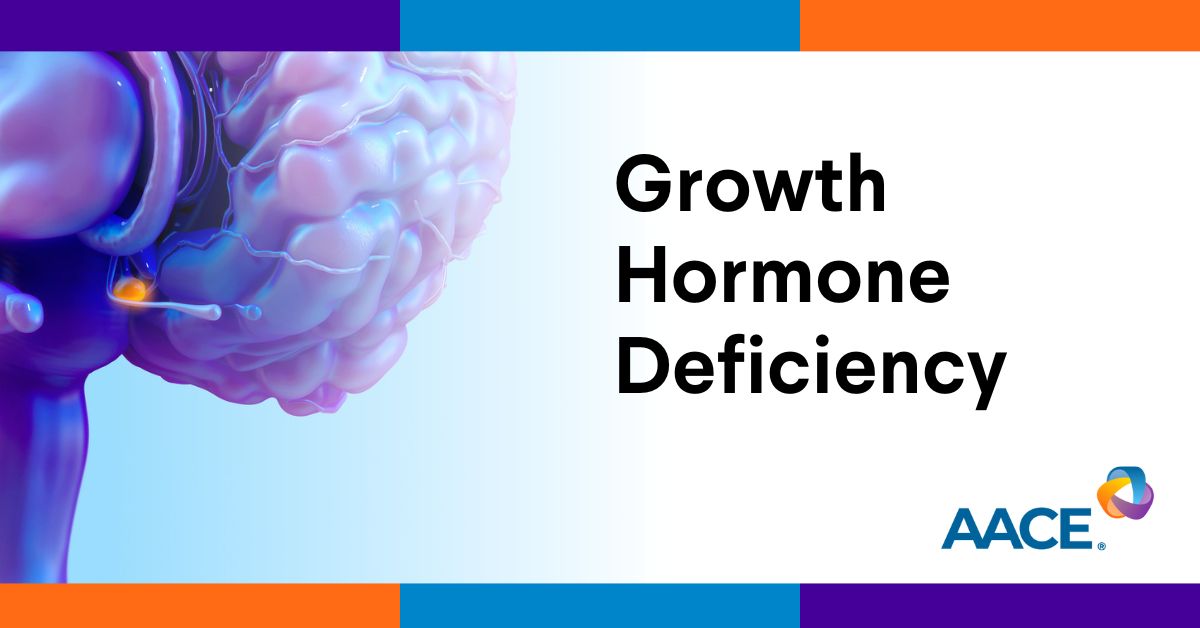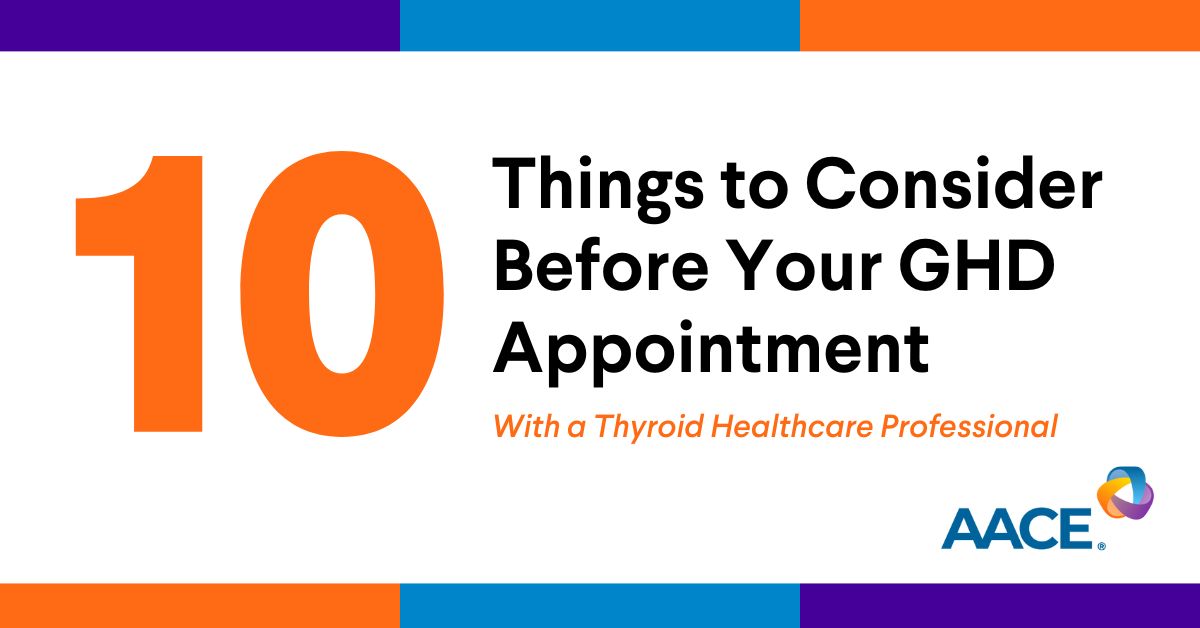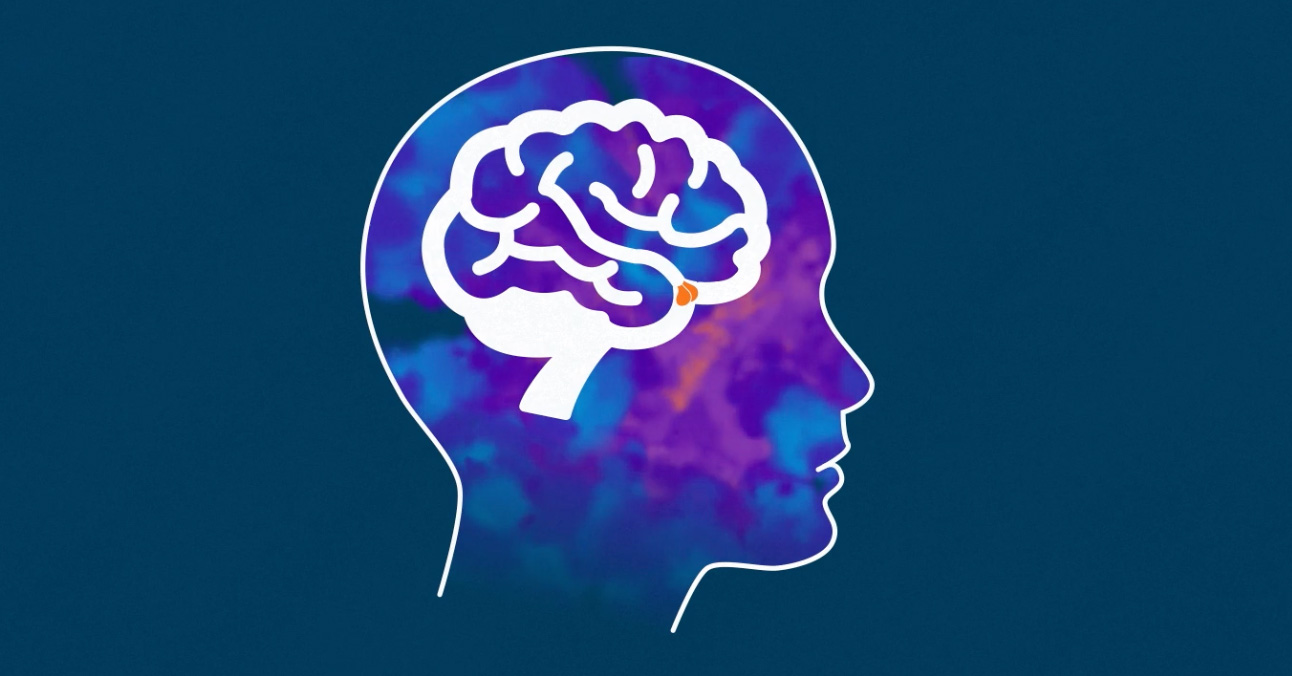Growth hormone deficiency (GHD) is a condition that occurs when your pituitary gland is not working normally.
Your pituitary gland is a pea-sized gland located behind your nose at the base of your brain. It produces several important hormones, which are substances that help your body and other endocrine glands work properly. These hormones play a role in many body processes, including growth, blood pressure, energy, sexual function, and more. In fact, this tiny gland is so important that it is often referred to as your body’s "master gland."
One of the hormones produced by your pituitary gland is known as growth hormone, or GH. People affected with GHD produce low amounts of GH. This deficiency (low amount) of GH can affect their bodies in many ways.
There are three types of GHD:
- Congenital GHD: Having congenital GHD means you were born with it. Congenital GHD happens as the result of changes (mutations) in certain genes before birth or because of problems with the structure of your pituitary gland.
- Acquired GHD: Acquired GHD can also occur (be acquired) at any time during your life. Some causes of acquired GHD include a tumor in your pituitary gland, surgery to your pituitary gland, radiation to your brain or pituitary gland, diseases that directly affect the pituitary gland, and traumatic brain injury (such as a car accident or sports injury).
- Idiopathic GHD: In medicine, the word “idiopathic” means “unknown.” If you’re diagnosed with idiopathic GHD, that means your health care professional cannot pinpoint the exact cause of your GHD.
Having low GH during your childhood years can affect how your body grows, which means it can lead to small body size, short height, and short bones in children. In both children and adults, low GH can impact other functions in your body, such as the way your body breaks down food, your blood sugar control, the strength of your bones and muscles, the health of your heart, your weight, your mood, your mental concentration, and even your memory.
Discover more about the types of GHD, its signs and symptoms, screening, diagnosis, treatment, and how to actively participate in managing your health through shared decision-making with your healthcare professional.
If you have GHD, you and your health care professional may notice one or more of the following signs or symptoms:
In children:
- Delay in bone growth and lengthening
- Extra body fat
- Slow growth or short height during infancy or childhood
- Late puberty or absence of puberty
- Young-looking facial appearance
In adults:
- Decrease in the size or strength of your muscles
- Decrease in how well or how long you can do activities that require muscle strength
- Decrease in your bone density, which raises your risk of future osteoporosis (thin bones)
- Extra body fat, especially around your waist
- Physical fatigue (lower-than-normal energy levels)
- Changes in heart disease risk factors, such as abnormal cholesterol levels
- Depression or anxiety
- Trouble concentrating or lack of interest in doing things you need to do
- Less interest in spending time with others (social isolation)
It’s important to remember that these are not the only signs and symptoms of GHD in adults, and not every adult with GHD has them. You may have few or no signs of GHD, or you may have symptoms that overlap with other medical conditions.
It’s very important to be as open as possible with your health care professional about your medical history, especially as it relates to possible causes of GHD. For example, be sure to tell your health care professional if you have had a pituitary tumor, previous pituitary or brain surgery, and/or radiation to your brain or pituitary gland, or if you have experienced a head injury in the past.
During childhood, health care professionals weigh and measure children regularly as part of routine medical checkups. They use growth charts to determine how a child’s height and weight compare with other children their age. If growth is slow, a child’s health care professional may recommend testing to find out what is causing slow growth and to check for GHD.
The earlier GHD is diagnosed in childhood, the better. Early treatment makes it more likely that a child’s bones will grow properly, they will avoid delays in starting puberty, and they will reach a normal adult height.
In adulthood, your health care professional will screen you for GHD by asking you about your symptoms, your medical history, and your history of previous brain surgeries, radiation, and traumatic injuries. Then a blood test is performed to measure a hormone called insulin-like growth factor I (IGF-1). If this hormone is low normal and low, then the next step will be to undergo a GH stimulation test. Early treatment is also important for adults, because it can help prevent the development of GHD-related medical conditions such as excess weight gain, type 2 diabetes, low bone density, and heart disease.
To confirm if you have GHD, your health care professional may suggest that you take a growth hormone stimulation test, or GH stimulation test. This test measures the ability of your body to produce GH after stimulation with a GH stimulating medication.
Here’s a basic idea of what you can expect during a GH stimulation test. Your health care professional will explain it in more detail:
- Your health care professional inserts an IV (intravenous line) into a vein in your body (usually, the back of your hand or inside of your arm).
- You will receive an injection of a GH stimulant. This medication tells your pituitary gland to release GH into your bloodstream.
- During the next two to four hours, your health care professional will monitor you closely and will take blood samples from your IV several times — usually every 30 minutes. These blood samples tell your health care professional how much GH is in your blood and whether your pituitary gland is making the amount of GH that your body needs.
Your health care professional may recommend one or more of the following tests in addition to or instead of a GH stimulation test:
- An X-ray to check bone growth in your hand (children and teens)
- Blood tests that check whether you have normal levels of pituitary hormones other than imaging (such as magnetic resonance imaging, or MRI) of your head, which looks at your brain, pituitary gland, and other structures
- Tests for various other types of medical conditions or hormone deficiencies that may affect growth, including celiac disease (when gluten in food causes damage to your small intestine and limits your ability to absorb nutrients from food and, in some cases, to grow normally) and thyroid diseases (conditions that affect your thyroid, which is another important hormone-producing gland)
- Genetic testing (usually only for children and teens)
Once your health care professional has done all necessary medical tests, they make a diagnosis. After sharing your diagnosis with you, your health care professional will talk with you about your treatment options. Be sure you understand everything your health care professional is telling you, so the two of you can work together to make shared decisions about your care going forward.
It's important to have your symptoms checked by an experienced health care professional because symptoms of GHD can be similar and may be mistaken for other conditions.
Because GHD is a rare condition, it may go undetected or undiagnosed for some time. You can help make sure you receive the testing and treatment you need by advocating for yourself with your health care professionals.
Some ways to do that include:
- Writing down a list of symptoms before your appointment and sharing it with your health care professional
- Asking questions
- Understanding the tests your health care professional is recommending
- Educating yourself about GHD and its treatment
- Understanding the treatment plan your health care professional is recommending
- Seeking a second opinion from another health care professional if you have concerns about your diagnosis, if treatment is not providing symptom relief, or if you feel that your health care professional is not listening to you
Learn more about how to prepare for GHD medical appointments by viewing our helpful guide, "10 Things to Consider Before Your Growth Hormone Deficiency Appointment."
Health care professionals treat GHD by giving you medicine that contains the GH your pituitary gland doesn’t make enough of on its own. This treatment is known as GH replacement therapy. GH replacement therapy brings your GH to the level that’s right for your age.
GH replacement therapy is given through injections (shots) of a medicine that is virtually identical to the GH made by your body. Your health care professional may refer to your GH replacement therapy by various names.
GH injections are usually given once a day, and recently, a once-a-week GH injection has become available. Your health care professional can talk with you about whether which GH formulation is right for you and if your health insurance will cover them.
Your health care professional will talk with you about what side effects to watch for when taking GH injections. These may include injection site reactions, headache, muscle or joint pain, increases in blood sugar or blood pressure, and ankle swelling. Generally, people tolerate GH injections well and have few or no side effects. Be sure to tell your health care professional if you’re having any side effects, so they can work with you to help manage them and/or adjust your GH dose.
If your health care professional prescribes GH medication, they will give you or your caregiver the instructions and support necessary to learn how to inject it at home. Your health care professional will also tell you how to store your GH medication and how to dispose of used needles safely.
Health care professionals usually start you with a low dose of GH medication and increase the dose gradually over time. Dose changes may be based on your age, weight, side effects, blood hormone levels, and other factors.
Although the thought of giving yourself or someone else daily or weekly injections may seem scary, most people find that with training and support, they soon become comfortable giving these shots at home.
It’s important that you take your GH injections as recommended. Skipping doses, taking less medication than prescribed, or going off your medication without first discussing it with your health care professional could lead to problems for you in the future. For example, growth may slow down in children, or you may develop GHD-related medical conditions during adulthood, including type 2 diabetes and heart disease.
Remembering to Take Your GH Injections
It can be difficult to remember to take your GH injections on a daily or weekly basis. But it’s important to follow your health care professional’s instructions for taking GH injections, so you can get the most benefit from them in the long term.
Here are some tips for creating an injection routine:
- Take your injection at the same time each day, or the same day each week, so you build a habit of remembering it.
- Link your injection to something else you do, such as eating breakfast, coming home from work/school, or going to bed.
- Set reminders on your smartphone or calendar to take your injection.
- Ask famliy or friends to check in with you to see if you’ve taken your injection.
- Set reminders to renew your injection prescription and pick it up from your pharmacy.
- Take advantage of free delivery of your injection reflils if your pharmacy or health plan offers it.
- Leave your medication in a place where you’ll see it. (Be sure to follow label instructions about how to store your medication, whether in the refrigerator or at room temperature.)
- Use a calendar or your smartphone to check off when you’ve had your daliy or weekly injection.
- Have all your injection supplies in one place, so you don’t have to spend time searching around your home for your supplies.
- If you have trouble remembering to take your injection, ask your health care professional for help.
- Different brands have different types of injectors. If you’re having trouble using your current injector, talk with your health care professional about whether your insurance wlil cover a different injector that’s more user-friendly.
- When you take an injection, take a moment to be mindful of how it’s helping you, and thank yourself for performing an important act of self-care.
Once you receive a GHD diagnosis, you should see your health care professional regularly. Be sure they let you know how often you should see them for follow-up care.
Your health care professional will do blood tests periodically to make sure your GH dose is where it should be. Children are usually retested with a GH stimulation test during puberty, when they have reached their expected height, or as they near adulthood.
If your health care professional has prescribed GH injections, it’s important for you to continue taking them as long as they tell you to, so you can get the most benefit from them. Taking regular injections isn’t fun, and you may get tired of them, especially if you’re not having symptoms. If you’re a teen, you may not like having health care professionals and your parents telling you what to do. That’s understandable. But if you don’t follow your treatment plan, it may cause health problems for you in the future.
Talk with your health care professional if it’s hard for you to take your injections every day. You may be a candidate for long-acting GH injections that can be taken weekly, rather than daily.
Transitioning From Pediatric Care to Adult Care
When children with GHD reach their teen years, they can begin to transition from pediatric care to adult care. The adjustment from pediatric to adult care can be difficult and stressful, especially if you have received care from the same pediatric health care professional for a long time.
You and your caregivers can make a plan early to help ensure a smooth transition by taking these steps:
- Ask your pediatric health care professional to recommend an adult care provider that they trust.
- Check to make sure the recommended adult health care provider accepts your health insurance.
- Talk with your pediatric care professional about what testing you may need before you move to adult care.
- Ask your adult health care professional which medical records and test results they need. Work with the office staff in both offices to make sure your pediatric records are sent to your adult care office.
- When you see your adult health care professional, ask them to review your testing and treatment plan. Talk with them about whether any changes should be made to your treatment plan.
- Be sure to write down any questions you may have, and bring them with you to your appointment so you don’t forget to ask anything. You might want to bring along a family member or friend to take notes during the appointment.
- Ask your adult care provider how often you should have follow-up care, and don’t forget to schedule those appointments.
- If any issues arise during the move from one provider to the other, ask them to communicate with each other, and follow up to make sure the communication has occurred.
- For more tips on preparing for GHD medical appointments, download our helpful guide, "10 Things to Consider Before Your Growth Hormone Deficiency Appointment."
People with GHD sometimes stop treatment when they reach adolescence or adulthood or when they achieve a certain height. Or they might stop seeing a health care professional for GHD. Many incorrectly believe that they no longer need treatment because they’re no longer growing.
In fact, some health care professionals without special training in endocrinology and GHD may not realize that adults with GHD continue to benefit from GH-replacement therapy. They may not know that even though adults produce less GH than children, and adults no longer grow as children do, adults still need enough GH to remain healthy.
The AACE Clinical Practice Guideline for Management of GHD in Adults and Patients Transitioning From Pediatric to Adult Care recommends that you and your doctor discuss whether you should continue your GHD treatment during adulthood to reduce your risk of developing future GHD-related complications. To decide whether you should continue treatment, you and your health care professional should consider all of the possible benefits and risks relevant to you.
Studies have shown the safety of long-term GH-replacement therapy when it is used properly at the correct doses. However, if you have questions about whether it’s right for you, please discuss this with your health care professional.
Living With GHD
No two people with GHD have the same experience. However, by receiving proper care and treatment, and by working closely with your health care professional, you can live well with GHD and reach your health goals.
Be sure to tell your health care professional if GHD symptoms are affecting your daily life or if you have side effects from GH replacement therapy. They may be able to recommend steps to help you feel better.
Patient perspective videos
Amy, a mother of an eleven-year-old boy, shares her son's journey after being diagnosed with growth hormone deficiency at the age of four, highlighting how working with an endocrine care team has supported his appropriate growth and well-being.
Lindsay, received a diagnosis of growth hormone deficiency (GHD) as a result of a Craniopharyngioma brain tumor. Listen to her share her journey of transitioning from GHD pediatric care to adult care, and how working with an endocrine care team has improved her quality of life.
The following resources, support groups, online communities, and advocacy groups offer information and support for people who live with GHD:





